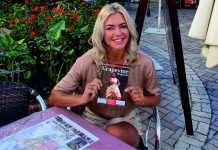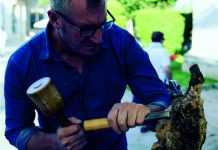
Although international flights are available into both Phnom Penh and Siem Reap, our meagre budget meant that we had to opt for the “luxury” bus option from Bangkok in Thailand. Now a bus that only cost 400 Baht (around 8.75 €) but described as luxury seemed to be a contradiction in terms; but it did have air conditioning and a free roll filled with what appeared to be coconut jam, so this was good enough for us. Some 4 hours later we arrived at the border of Thailand and Cambodia at Poipet. The 2 ½ queue through immigration was long and hot, but eventually we were through and on the bus to Siem Reap. The difference in wealth between Thailand and Cambodia is instantly apparent just by the clothes people wear and the cars on the roads. The bus on the Cambodian side was far from luxury and seemed to be devoid of suspension. This added to the fact that the road was a – sometimes single track – dirt track, made for an uncomfortable 6 hour ride. The driver seemed to have the bus's horn attached to the accelerator pedal and every car, truck or bike that came near our bus was greeted with blasts of his horn. In fact the only thing that did not was the odd cow that wandered across the road.
Eventually we arrived in Siem Reap and past the luxury hotels near the airport. Sadly there was no 5 star hotel waiting for us. Our guesthouse as it turned out was clean and with a comfortable bed; a bargain at $6. But alas, $6 does not get you a hot shower.
Cambodia has a dual currency economy. The local currency is the Riel ($1 = 4,000 Riel) and it is quite the norm to receive a combination of both as change.
The high majority of the visitors Cambodia undoubtedly come to visit the temples in Siem Reap. The temples cover an 80 square kilometre area, so there is much, much more to see then the fantastic Angkor Wat – the biggest religious building in the world. We arranged for a tuk-tuk driver to ferry as around to and from the temples. Our tuk-tuk driver was a very friendly lad called Coln. When we told him we lived in Spain, he instantly started speaking to us in Spanish, explaining that he was learning the language to better the chances of becoming a guide at the temples. He showed us the book he was learning from. It was a battered, photo-copied text book only in Spanish. He explained he was translating the Spanish words into Khmer, though quite how he managed that I do not know. We opted for a 3-day pass which cost $40 deciding this would best allow us to see the temples we had chosen from the many guide books we had read. Once you have purchased your ticket, you are able to go to the temples to see the sunset. This sounded like a good idea until we reached Phnom Bakheng temple and realised that at least a thousand other people thought it was a good idea too.
Over the next 3 days we saw Angkor Wat which was lovely but typical of any visit of ours to famous landmarks was covered in tarpaulin and partly closed for maintenance work. We also visited Bayon, with its famous Buddha faces carved into the stone. Ta Prohm is like something from a film set with trees growing dramatically through the stones. Whilst at Angkor Wat you can easily be wandering around with a few hundred other people, other, at more remote temples there can be just a few of you, giving a sense of tranquillity. For the last day we travelled 49 kilometres in the back of the tuk-tuk (which was very dusty and bumpy) to visit Phnom Kulen and Kbal Spean, which again were fascinating. Travelling by tuk-tuk for such a distance enabled us to get a really close look at the villages & landscapes through which we travelled. On the way to Phnom Kulen we passed a team of people clearing land mines. We had read that around 35 people a month (and many cows) still get killed or maimed by land mines. This made it seem very real. You see many land mines victims as you travel around Cambodia. Although there are many of these victims, you are less likely to be accosted by beggars than on a trip down Oxford Street. Many of the victims have signs on their stalls/trolleys/musical instruments saying “I don't want to beg, please support me”. There is no Social Security system so the support of tourists for many is the difference between life & death.
It was then time for us to leave Siem Reap and head for Phnom Penh. This meant another bus ride which turned out to be more comfortable and was over relatively quickly. We checked into another $5 guest house; this one was on the Boeung Kak lake with a sunset to die for. However, the toilets were not the cleanest so we decided to check out and, as our holiday was coming to an end, push the boat out. We found a hotel with air con and, at last hot water for the princely sum of $18! On first impressions I did not like Phnom Penh in comparison to Siem Reap. It was busier both in terms of people and traffic and very polluted. However after the five days we spent there it grew on me. The people were friendly and we managed to find some great restaurants. One of the restaurants was called Friends and was a charity operated to help street kids. Every day they help 1,800 kids to find work, to feed them and to train them. The restaurant is staffed by such “kids”. The food was so good, we bought the cookbook. In fact the food pretty much everywhere in Cambodia was excellent. The French colonised Cambodia and their influence is apparent in terms of the culinary and the architecture. During our time in Phnom Penh, we visited the Killing Fields where the Khmer Rouge executed thousands of men women and children. Estimates vary as to how many people were killed, but an average estimate is 2 million which equated to 30% of the population at the time. It is hard to believe that Pol Pot and eleven others were able to start the Khmer Rouge and kill so many people. These killings took place over 4 years of power and with around only 1,500 core Khmer Rouge members. We also visited Tuol Sleng, a former school turned into a security prison by the Khmer Rouge. The prisoners were held here before being tortured and then taken to the Killing Fields based in the “confessions”. Over 17,000 political prisoners were “processed” at this one site, only 6 survived. The grim pictorial evidence we saw showed scared people of all ages with a sign round there neck with prisoner number an date. Some were dated 1977, I was 12 and enjoying life blissfully unaware of the terror being inflicted on the Cambodian people. The Khmer Rouge was overthrown in 1979 by the Vietnamese, this lead however to another 20 years of civil war.
So to round off Cambodia's many facets, we have Sihanoukville in the south of the country. Sihanoukville has white sandy beaches and is relatively un-spoilt. Although there are rumours of developing the resort a lot to attract more tourists. Sadly, we did not have time to fit a visit to Sihanoukville into our busy schedule. Maybe next time. If you would like to find out more about Cambodia, its people and history, I would heartily recommend the book The Kings Last Song by Geoff Ryman. Although a work of fiction it has a story based around the history of the temples and Khmer Rouge and captures the country and the Cambodian people perfectly.
Andy Wilkes




















